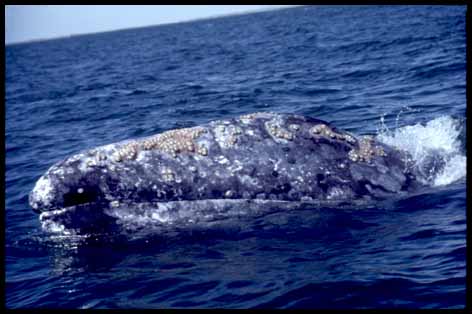 |
|
||||||||||||||||||
|
Eschrichtius robustus |
|
| WHEN YOU CAN SEE THE GRAY WHALES: Gray whales can be seen from the highway turnouts in Big Sur from December through April. December to early February the California Gray Whales are migrating south. Beginning in February you begin seeing whales migrating back to Alaska with their newborn babies by their sides. There is sometimes what appears to be an overlap in migration patterns with some whales still heading south while others are moving north. On their northern migration they swim close to shore, with their babies on the shore side. It has been said this is to protect them from attacks from Great White Sharks. This is often when the best viewing can take place because they are moving more slowly because of their young calves and also they are swimming against the current. Another spectacular sight is watching them as they migrate south. Occasionally the water is filled with spouts going off one after another, looking like a long line of steam locomotives spouting out in the ocean.
The entire population of Gray Whales migrates past the Big Sur coastline twice a year. Once when going south to the lagoons of Mexico (late fall-early winter) and once again when returning to Alaska (late winter-early spring). Bring your binoculars and enjoy this spectacular sight from the many roadside turnouts, restaurants, and cafe's.
Gray whales are medium sized whales, reaching up to 45 feet in length. Males grow to 45 feet - longer than a city bus - and females are slightly larger. The average weight of a gray whale is 16 tons (32,000 pounds) and some have reached weights of 30 to 40 tons. They are gray with white patches, which mostly consist of areas where barnacles and lice have attached themselves to the whales. They have no dorsal or back fin. Instead, they have a low hump and a series of six to twelve knuckles or bumps. The gray whale is a baleen whale and has approximately 300 plates of cream-colored baleen hanging from its upper jaw. Two to five throat creases which allow for limited expansion of their throats during feeding. Sparse hairs are found on the rostrum, especially in young whales. Gray whales surface surface every three to five minutes to breath and can remain submerged for up to 15 minutes. RANGE/HABITAT: Today, 23,000 gray whales are found only in the Pacific. The main population summers north of Alaska in the Bering and Chukchi Seas and winters in the waters of Baja California. Another population in the Pacific, found in the waters of Korea and Japan, is close to extinction with less than 50 individuals. A population of gray whales once lived in the North Atlantic Ocean and became extinct in the 17th century, due to hunting. Gray whales generally stay around the continental shelf and are truly a coastal species. NOTES: Gray whales have one of the longest migrations of any mammal. During summer, they live in the Arctic in areas rich in their food, bottom-dwelling organisms. As fall approaches, there is less sunlight, less food, and the water turns cold. This is when the whales travel to Baja California, where they enter lagoons to give birth and mate. Gray whales can be seen passing by California in December and January during their southern migration, and again in March and April on their northern journey. Gray whales feed differently from other whales. They stir up shallow coastal areas, sucking in the bottom dwelling animals, mostly amphipods (which are related to shrimp). Muddy plumes of water are often seen in places where gray whales are feeding. Female gray whales usually give birth every two to three years, and gestation lasts twelve to thirteen months. Newborn calves are 12 to 15 feet in length and weigh about 1,500 pounds. Calves are weaned at about eight months, after they have journeyed with their mothers back to the northern feeding grounds. Gray whales have returned from the brink of extinction. In the late 1800's, the gray whale breeding grounds were discovered, and whalers decimated the population. The drop in population made it no longer profitable to hunt gray whales; they were left alone and their numbers recovered. However, the early 1900's brought the invention of factory ships, which processed whales aboard the vessels. This new technology allowed intensive hunting on the grays once again, and their population again dangerously dropped to probably fewer than 2,000 individuals. Protection came finally in 1946. Since that time, the population has grown to over 21,000--probably what it was before modern day whaling. As a result of this population recovery, gray whales were removed from the endangered species list in 1994. Since gray whales migrate relatively close to shore, whale watching for them has become very popular. Many opportunities are available for viewing whales from coastal cliffs and headlands or whale watching boats. In recent years, "friendly whales" have been encountered in San Ignacio Lagoon in Baja California in Mexico. Here, gray whales will sometimes swim near small skiffs and allow themselves to be touched. Concern has grown about the impact of boat traffic around whales, and the number of boats allowed in the breeding lagoons is restricted. Along the migration route, boats' proximity to whales is also limited. This information supplied by The Marine Mammal Center
|
|||
Big Sur Chamber of Commerce - http://www.bigsurcalifornia.org (831) 667-2100

